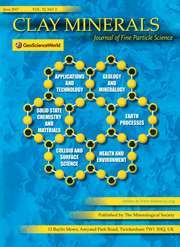No CrossRef data available.
Article contents
Clay colloids and the potter
Published online by Cambridge University Press: 14 March 2018
Extract
The mode of formation and the particle size distribution of potters' clays, particularly china clays and ball clays, were discussed in this paper, emphasis being laid on the proportion of colloidal material present. From this information, it was found possible to estimate the proportion of colloid in pottery bodies. After a brief indication of the structure of the clay minerals involved, the colloidal properties of clay were considered in some detail, particular attention being paid to the development of the Gouy-Freundlich diffuse double layer and the effect of exchangeable ions on this.
The theory of deflocculation of clay slips is based on the diffuse double layer and the development of an adequate potential. The anions are considered to be located on the surface of the particles which have associated lyospheres the size of which is dependent on the cation present.
- Type
- Research Article
- Information
- Copyright
- Copyright © The Mineralogical Society of Great Britain and Ireland 1950


